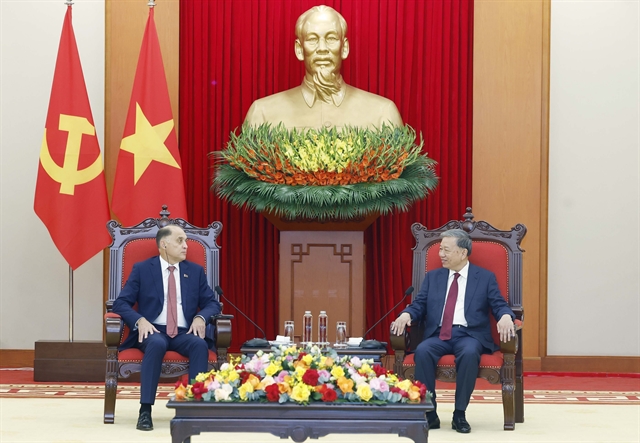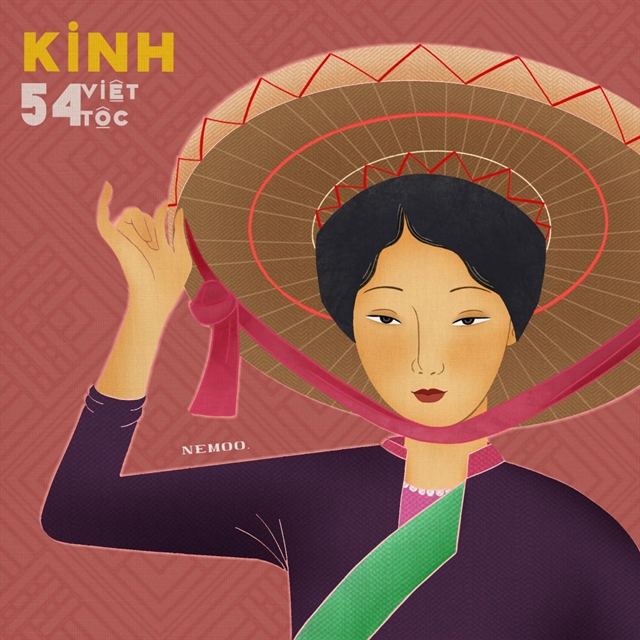 Features
Features
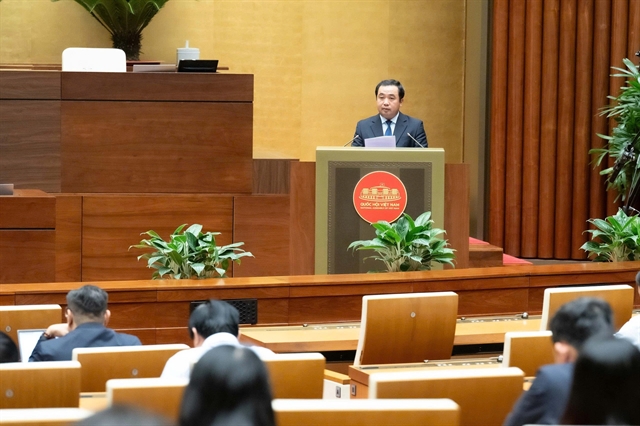
The collection of 23 sắc phong (king's certificates to confer titles on people) dating from the 18th century at Trấn Vũ Temple, Long Biên District, Hà Nội, were recognised as rare and precious documents.
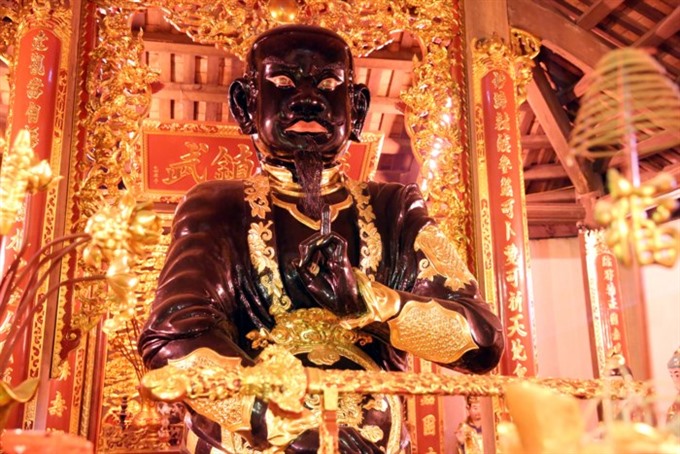 |
| Historic item: The bronze statue of deity Trấn Vũ at the temple is a National Treasure that needs to be preserved and researched, experts say. VNA/VNS Photo Minh Đức |
By Minh Thu
Mai Tự Lĩnh, 71, and his villagers eagerly prepared for the annual festival at Trấn Vũ Temple, Long Biên District, Hà Nội, several weeks before the grand opening.
This year the festival was more special than ever as 23 sắc phong (king’s certificates to confer titles on people) dating from the 18th century were recognised as rare and precious documents.
Chairman of the Hà Nội People’s Committee Nguyễn Đức Chung issued the decision on the occasion of the Trấn Vũ Temple festival held on April 16-19. Accordingly, the collection of royal edicts in which the kings honoured Trấn Vũ patron deity will be preserved, digitalised and researched further by the Archives Department.
All of the edicts are original, written on poonah paper with dragon-drawing decorations and imprinted with the kings’ stamps. They were issued during different dynasties including the Lê, Tây Sơn and Nguyễn, from 1740-1940.
“This is a big source of pride for us,” Lĩnh said.
People from Ngọc Trì Village have preserved items of cultural heritage at Trấn Vũ Temple for many centuries, however not many people are aware of these relics. Now, thanks to the government’s recognition, more and more people can learn about the uniqueness of statues, architecture, royal edicts and rituals of Trấn Vũ Temple.
Temple of heritage
Lĩnh said Trấn Vũ was devoted to help the king fight against invaders and protect the people from evils and natural calamities, according to legend.
The festival honouring the deity has been restored and organised for the last 20 years.
“The local people are determined to respect the god and believe in his supernatural power,” he said.
“The temple is a holy place for us and villagers often burn incense and pray for peace and prosperity.”
“Organising the festival is an opportunity for us to pay gratitude and respect to the deity. It’s also an occasion when we enjoy a feast and play sitting tug-of-war.”
According to the legend, the area was once hit by drought. Twelve wells in the village went dry, except the one in Đìa Village. People flocked to the well to get water. But villagers living near the well prevented the others from doing so for fear that the water would soon dry up too.
The two sides battled, pulling buckets and poles. They sometimes sat on the ground to pull for fear that the water might spill. When the drought ended, elders believed that playing tug of war at the local temple festival was a wish for a year of good weather.
The unusual game was listed as a national intangible heritage and as an intangible cultural heritage of humanity by UNESCO in 2016.
Ngô Quang Khải, head of the temple’s management board said the game was not played during the war and for more than a decade after national reunification in 1975. In 1989, the villagers restored the event and held it on the same day of the local festival.
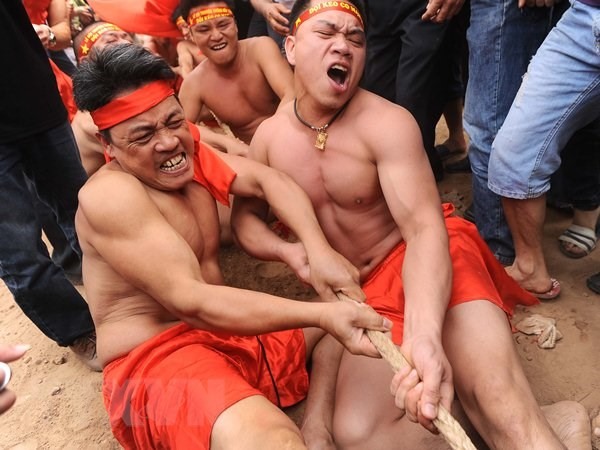 |
| Traditional game: Playing sitting tug of war at the local temple festival as a wish for a year of good weather. VNA/VNS Photo Minh Đức |
In the game, two teams sit on the ground and tug a rope 50m long that is passed through a hole in a wooden pole fixed firmly on the ground.
“The game symbolises the desire of farmers for good luck, bumper crops and favourable weather conditions,” said Khải.
“It also reinforces and renews social relationships and strengthens communal solidarity. Therefore, the focus is not on winning but on enjoying the game thoroughly.”
Khải said the rope is made from rattan stems which are about 30 years old. He stressed that using rattan for the sitting tug-of-war game is necessary because it follows history and tradition.
Extraordinary statues
While the statue of Trấn Vũ at Quán Thánh Temple (Ba Đình District) is very well-known among Hanoians and tourists to the city as the deity guarding the north of the capital, not many people know that Trấn Vũ Temple in Long Biên District also houses a statue of the deity which is very similar to the one worshipped at Quán Thánh Temple.
The four-tonne bronze statue at Trấn Vũ Temple was recognised as a national treasure in 2016.
According to experts, people along the Red River dyke worshipped St Trấn Vũ in order to pray for good weather and flood control. However, only the statues at Quán Thánh Temple and Trấn Vũ Temple are made from bronze and embrace the high skill of craftsmen representing the art and technique of people living in that era.
According to a stone stele at the temple, King Lê Thánh Tông (1442-1497) on the way to a battle, stayed one night at the location where the temple is now.
He met Trấn Vũ in his dream and the deity promised to help him fight the enemy. The king, thus, built the temple. The statue of the deity was carved from wood at the beginning. After many years, the wooden statue was damaged so local people raised funds to cast a bronze statue of the saint. After 14 years, the statue was completed.
The statue was painted black and trimmed with gold. According to the legend, snakes and turtles are inferiors of the saint. The knees of the statue were covered with the faces of tigers, trimmed with gold.
Apart from the statue of Trấn Vũ, there are 12 statues of generals subordinating the god. They have been carved to look scary, one is hairy, one has three heads and eight hands, one’s mouth is like a bird’s beak, and one has the face of a frog.
According to historian Trần Lâm Biền there are many explanations of these statues’ bizarre appearance.
“They may be 12 mandarins who are in charge of affairs taking place in each year of a zodiac circle, or gods who help Trấn Vũ defeat demons,” he said.
“No matter who the mandarins are, they proved the good skill and technique of the craftsmen in the old days,” said Biền.
Biền once again affirmed that Trấn Vũ Temple houses many valuable cultural relics that require the preservation and deep research. VNS

